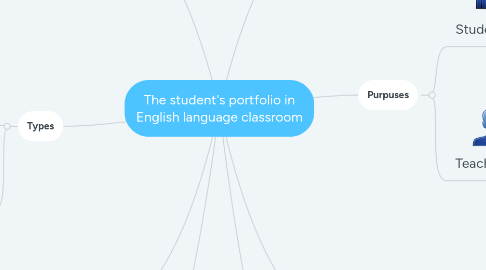
1. Characteristics
1.1. Monitoring students' progress (Assessment portfolio)
1.1.1. Formative
1.1.2. Summative
1.1.3. Culminating
1.2. It is multidimensional, reflecting aspects of students' learning process
1.3. They monitor their own comprehension, their approaches to problem-solving and decision-making
1.4. They focus on students' performance-based learning experiences, knowlegde, skills and attitudes
2. Types
2.1. 1. Process Portfolio
2.1.1. Documents the stages of learning
2.1.2. Provides a progressive record of student growth
2.2. 2. Product Portfolio
2.2.1. Demostrates a set of learning objectives and contains only the best work.
3. Portfolio Assessment
3.1. Criteria for a finished portfolio
3.1.1. Rubrics
3.1.2. Rules
3.1.3. Scoring keys
4. Authenticity
4.1. A portfolio is authentic in that its contents go beyond the collection of traditional worksheets, graded assignments and end-of-unit tests to include a variety of items
5. What is a Portfolio?
5.1. Collections of Student's work
5.1.1. Alternative assessment approach in the classroom
5.1.2. Demostrate knowledge of a topic
5.2. Examples
5.2.1. -Projects
5.2.2. -Assesments
6. Purpuses
6.1. Students
6.1.1. Promote their self-evaluation, reflection and critical thinking
6.1.2. Provide opportunities for them to discuss
6.1.2.1. Learning goals and the progress
6.2. Teachers
6.2.1. Mesauring performance based on samples of student work
6.2.2. Providing flexibility in measuring how students accomplish their learning goals
6.2.3. Establishing learning goals and evaluate progress
6.2.4. Facilitating cooperative learning activities
6.2.4.1. Including peer evaluation, tutoring and cooperative learning groups.
6.2.5. Providing a process for structuring learning in stages.
6.2.6. Including different types of data and materials
7. How to develop a portfolio?
7.1. 1. Organization and Planning
7.1.1. - How do I select items, materials, etc. to reflect what I am learning in this class?
7.1.2. - How do I organize and present the items, materials, etc. that I have collected?
7.1.3. - How will portfolios be maintained and stored?
7.2. 2. Collection
7.2.1. Artifacts and products
7.2.1.1. Particular subject matter
7.2.1.2. A learning process
7.2.1.3. Special projects, themes, and/or units.
7.3. 3. Reflection
7.3.1. Evidence of students' cognitive reflections about the learning process
